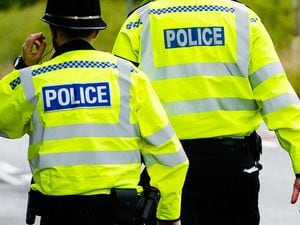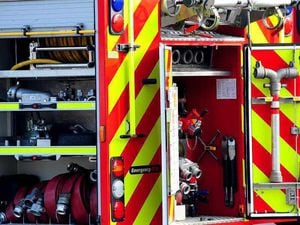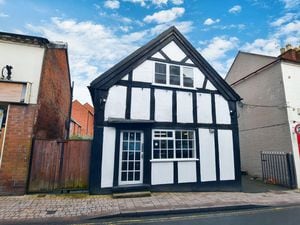Shropshire-based regiment prepares for Afghanistan
Royal Irish troops at Clive Barracks are preparing to leave their Shropshire base for a Nato mission supporting Afghan troops. Mark Andrews reports.
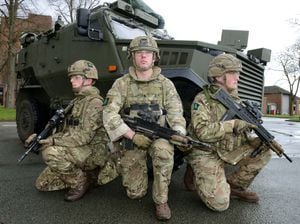
A Land Rover approaches the gate of a compound inside a Shropshire army barracks. The driver gets out, draws a weapon, and the ensuing exchange of gunfire leaves the assailant dead and a visiting American general with serious chest injuries.
Three armoured cars arrive, and there is a brief altercation as two civilian workers at the base protest at the amount of time troops are taking to check their vehicle while the general lies injured.
This is one of a number of exercises the troops at Clive Barracks in Tern Hill, near Market Drayton have been practising day in day out for the past few weeks as they prepare to head out to Afghanistan this month.
Members of the Royal Irish Regiment, which has been based at Tern Hill since 2007, will this month be heading for the city of Kabul, where they will be provide support to Afghan troops in the country's forthcoming general election.
WATCH: Troops undergo training for Afghanistan
Leading 1st Battalion's tour of duty will be Lt Col Matt Lewis, who has twice previously served in Afghanistan, his last tour being to provide security in the previous election in 2014.
Lt Col Lewis, who has 18 years' service in the Army, says one of the most rewarding things about the job are the changes that have taken place in Afghanistan over the past few years.
"I had to go back about two months ago, and one of the things that really struck me as I was flying over the city was how vibrant it was in the evening," he says.
"You could see the neon lights, the wedding halls and restaurants were open, it is really encouraging."
There are 580 troops stationed at Clive Barracks, about two-thirds recruited from Northern Ireland, most of the remainder from the Irish republic – although there are a few non-Irishmen in the regiment, such as Welshman Lt Col Lewis.
"I had a hard time during the six-nations, being surrounded by Irishmen," he jokes.
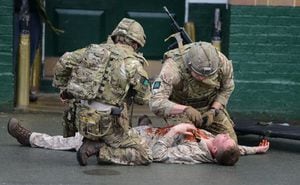
The troops will be taking part in Operation Toral, the British element of Nato's resolute support mission where British soldiers provide training and advice for Afghan services. It will be very different from Lt Col Lewis's last mission in the country, where he was actually providing the security.
As the troops practise their exercises around the grounds of the barracks, the skies open up and a hailstorm comes crashing down. A sentry hidden in the undergrowth, keeping watch for any passers by, remains resolutely focused. Presumably, this is what one calls all-weather training.
The regiment's transport comes in the form of a fleet of armoured cars known as the Foxhounds, manufactured by Leamington Spa based Ricardo Plc, which has supplied the Army with 325 vehicles at a cost of £300 million. For a £900,000-plus vehicle, the Foxhound is hardly the last word in luxury – the rear cabin, which will usually carry four troops, with the driver and commander sitting up front – is cramped, and the kit bags, or bergons as they are known, are mounted on the outside.
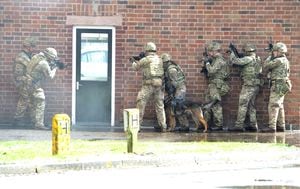
But it does have one special creature comfort, demonstrated by 25-year-old Ranger Chris Nelson, who is making a brew using the water boiler in the back.
"That makes all the difference," he says. "You can make tea, coffee, or boil your vegetables, it's multi-purpose."
Kabul will be Chris's first tour of duty. He says he is not sure what to expect, but is keen to put his training into practice.
"I'm looking forward to it," he says. "It's what you join up to do."
In another one of the exercises, the soldiers – accompanied by a four-legged member of the regiment – storm a building. The first Foxhound in the convoy pulls up alongside the entrance to the building, and throws a smoke grenade to provide a cloak of cover while the occupants of the two vehicles behind force their way in.
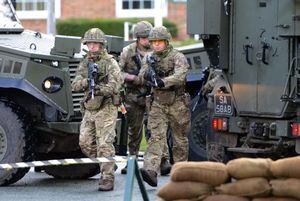
Among them is 19-year-old Private Bethany Johnson, who is joined on the exercise by five-year-old alsatian Csillag.
As the team make their way down a corridor in the building, the dog runs ahead of them. Fitted with a body camera which Bethany monitors through a screen attached to her arm, the dog searches each room to see if the enemy is lurking inside.
Halfway along the corridor, Csillag spots a man hiding in one of the rooms, and disables the suspect by fixing his jaw onto his left arm. The man is then apprehended and escorted out of the building, with Csillag following close behind.
Corporal Ben McGarrigle explains the importance of keeping the dog behind the detainee.
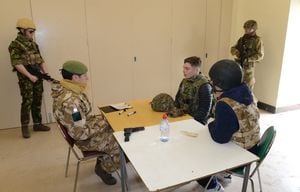
"He won't try to make a run for it with the dog behind, because he knows he will get a bite on the jacksy," he says.
Corp McGarrigle says the advantage of using a dog, rather than opening fire, is that it enables them to detain the man without causing serious injury, meaning he can be taken in for questioning.
After the exercise, with Csillag looking a model of docility, Bethany explains that the camera is able to give them a lower vantage point than the troops would get if they were unaccompanied.
"The enemy is often more surprised to see a dog," she adds.
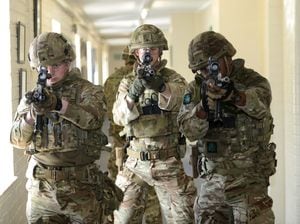
In Afghanistan troops are frequently used to provide security for meetings with local community leaders. This usually involves escorting an army commander – although it could also be a civilian, such as a politician or diplomat – to a meeting room, and then ensuring that the meeting passes off peacefully.
Demonstrating the techniques used, a VIP is greeted by a group of soldiers who brief him on the security arrangements before taking him aboard one of three Foxhounds. As they arrive at the meeting point, the vehicles park in a triangular formation, providing a 'safe space' in the middle, while one of the troops gets out to check no explosive devices have been attached.
The troops then enter the meeting room to check it is safe, and one remains in the room while the others return to the vehicles. The VIP is then escorted into the room. During the meeting, tensions are briefly raised when one of the men raises his voice, but an intervention by one of the troops calms the situation down.
Sgt Dean White says: "We are often dealing with different cultures, and sometimes things, such as raised voices, can sound quite serious, when actually they are not.
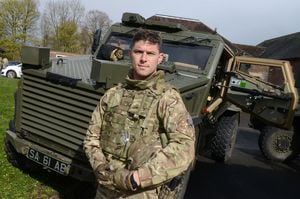
Corporal Ryan Brown adds: "We will always try do de-escalate the situation, such as by talking to the interpreter, asking him if the other person can keep his voice down."
During the exercise, the local leader's bodyguard becomes agitated at the length of time the meeting is taken, and pushes over a flip-chart in a fit of rage. The troops decide that their man is at risk, and bundle him out of the meeting room and escort him back to their vehicle, before returning to the other party to decide whether it is safe to resume the meeting.
Corp Brown, 29, has served in the Army for 10 years, and like the Lt Col, was in Afghanistan during the 2014 election. He says he has been present at hundreds of such meetings, and has never experienced any problems.
It will be a first tour of duty for 22-year-old 2nd Lieutenant Aidan Welch, who will be heading for Kabul on April 24.
Like his comrades, he says he is looking forward to the experience.
"It's a job you join up to do," he says."
"These days you get to experience a lot of the culture, and you meet some quite interesting people. It will be difficult, but I know I will be leading a very good team."


